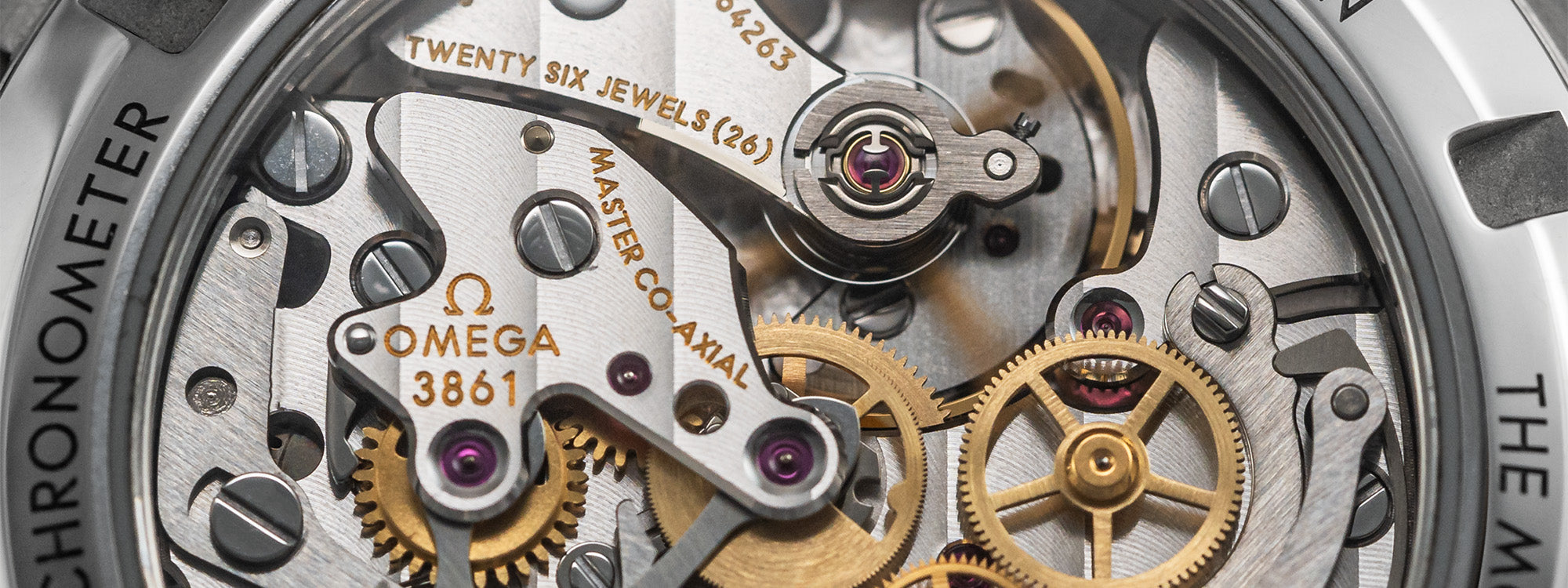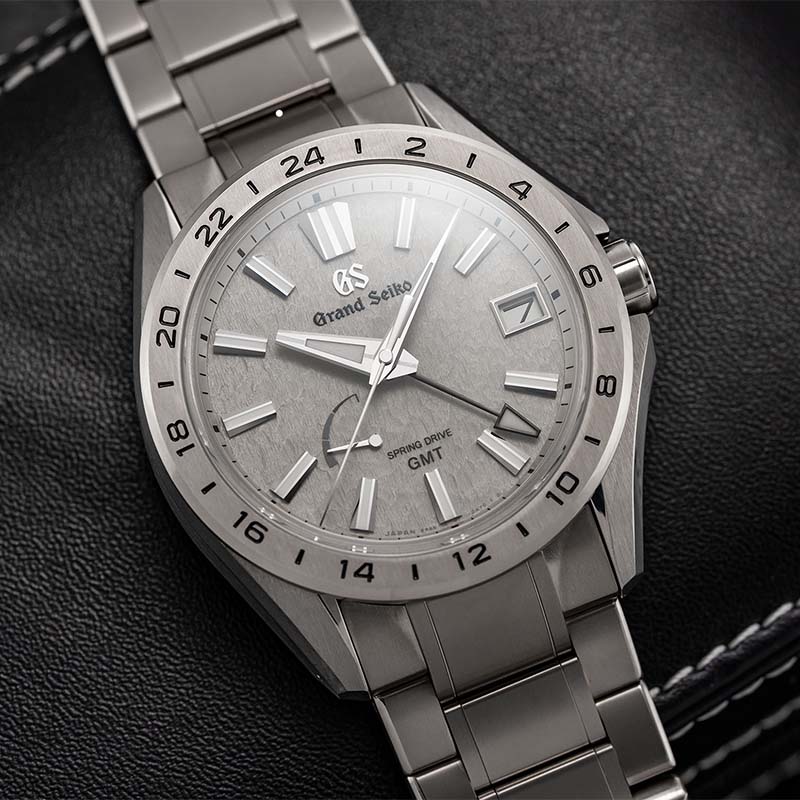Among the many questions a novice watch enthusiast is faced with, “Mechanical vs. Automatic Movement?” is one of the most basic, yet one whose answer is a bit more complex than a simple A-or-B explanation. In fact, “mechanical or automatic” isn’t even really framing the choice correctly. In the article below, we attempt to clarify the subject and answer the most pressing questions about these tiny engines inside your watch.
What is a Mechanical Movement?
A mechanical movement, like the Nomos DUW caliber below, uses a coiled metal spring, called a mainspring, that releases energy as it uncoils through a series of gears to drive a weighted, oscillating wheel called a balance wheel. The balance wheel’s oscillations are linked to an escapement, which periodically releases the gear train to move the hands forward to record the passing of hours, minutes, and seconds. In short, a mechanical movement in a watch is any type of movement that uses no batteries or electronic components to function — which makes them different from more modern inventions, like quartz, Spring Drive, and solar movements.

Technical developments over the centuries are what led to the two types of mechanical movements we’re discussing here. Originally, the movement’s mainspring needed to be wound periodically by hand — first by a key, then by a small knob called a crown that was attached via a stem to the movement. Later, a type of movement was developed that could be wound “automatically,” through the motions of the wearer’s wrist. (Because the word “automatic” is so often associated with electronic devices, and watches with quartz movements also don’t require winding, some have mistakenly referred to these types of watches as “automatics.”) Today, both types of mechanical movements are still being used in watchmaking.
What is the difference between a mechanical movement and an automatic movement?

Addressing the central question in our headline, the truth is that It isn’t really a question of difference. The latter is simply a specific type of the former, like cognac is a type of brandy and tequila is a type of mezcal. The two main types of mechanical movements are manually wound (or “hand-winding”), in which the user needs to periodically wind the watch via the crown to keep it working; and automatic (or “self-winding,” like the Longines caliber above), in which the mainspring is wound by a rotor (or “oscillating weight”), usually a rounded semicircular mass that swings with the natural motions of the wearer’s wrist. Continually wearing this type of watch will “automatically” wind it. Conversely, if the watch remains motionless for too long — say, in a safe or on a nightstand — its mainspring will run down and the watch will need to be wound and set again to start timekeeping anew. Manually wound mechanical watches are different: even if you wear it all day, every day, it will still need to be wound by hand every so often — usually every two to three days, depending on the power reserve.
How does an automatic movement wind itself?

By definition, all automatic movements use a moving weight connected to a gear train to wind the mainspring via the motions of the wearer’s wrist, so — aside from any additional complications incorporated into a given movement — there is very little difference mechanically in how they function. There are, however, different types of rotors. The most popular is a center-mounted, semicircular mass that somewhat resembles a hatchet blade (check out the example from Blancpain's Fifty Fathoms model above), can swing in either one direction or both, and covers about half of the back side of the movement when it’s at rest.

Some watches opt for a micro-rotor (above), a smaller version of the traditional semicircular rotor that does the same job but is recessed into the movement rather than mounted above it, allowing for the overall mechanism to be thinner. Piaget, which is known for ultra-thin watches, was one of the pioneers of this type of rotor, which is also used by brands such as Patek Philippe and Parmigiani Fleurier.

Another, rarer type of rotor is a peripheral rotor (above), which is designed to swing around the edges, or periphery, of the movement, the advantage being that the rotor doesn’t obscure the mechanical beauty of the components behind it as a traditional rotor does. Carl F. Bucherer was the first watchmaker to make a peripherally wound automatic caliber part of its regular lineup, and some other companies such as Cartier, Breguet, and Vacheron Constantin have also adopted it in some movements.
Who invented the automatic movement?

The first successful example of an automatic winding system is attributed to Abraham-Louis Perrelet (above), the founder of the modern Perrelet watch brand, in 1777. Shortly thereafter, a French inventor named Hubert Harton improved upon Perrelet’s design, and his version was subsequently refined by Abraham-Louis Breguet, who made the first self-winding watches that were sold to the public around 1780. These Breguet “Perpetuelle” pocket watches (below) fell out of favor around 1800, however, due to their inconsistent reliability (remember, pocket watches weren’t worn on the wrist and couldn’t benefit from a constant flow of dynamic wrist motions to wind the rotor). When wristwatches began supplanting pocket watches during World War I, automatic movements made a comeback: British watchmaker John Harwood filed the first patent for a self-winding wristwatch in 1923 and the style has been around ever since.
How do you know when you’re done winding a manual-wind movement?

Generally, about 30-to-40 clockwise turns of the crown will suffice to fully wind a mechanical watch; if your watch is equipped with a larger-then-average power reserve — like one of Panerai’s eight-day models — the number of turns required may well be larger. But keep in mind that a manually winding watch movement will usually indicate to you when its mainspring is fully wound. You’ll feel the tension as the spring gets taut, and a locking mechanism will engage to signal that winding is complete. Don’t attempt to force it after this point, as you could overwind the watch. Also, it’s best to try to wind such a watch daily, even if the manufacturer claims a power reserve of two days or more, because as the mainspring loosens, it can affect the accuracy of the timekeeping.
What are the pros and cons of manual-winding and automatic movements?

For automatic or self-winding movements, the benefits are pretty much all about ease and convenience, and fairly self-evident: a watch that keeps winding itself while it’s being worn requires far less attention from its owner than one that needs to be constantly rewound — and maybe even reset — regardless of how often it’s worn. This also means less wear and tear on the crown since the owner of an automatic watch will ideally not need to use it as much. Plus, as noted previously, consistent self-winding should also equal consistently accurate timekeeping, with none of the lag associated with manually wound movements as they near the end of their power reserve.

All that said, the more old-school manually winding movement offers some advantages of its own. A manually winding movement can be thinner and lighter, as it doesn’t require the presence of a weighted rotor. In a related vein, this same lack of a rotor can make a manually wound movement more visually interesting than a self-winding one, as this large component isn’t there to block the view of decorated plates and bridges and other moving parts behind it — an advantage especially in our modern era, in which many mechanical watches come equipped with clear casebacks to put the movement on display. Just imagine the view of the manually wound Omega Caliber 3861 above with half of its eye-catching elements hidden.

If price is a factor, watches with simpler, manually wound movements are usually a bit less expensive than automatics. Hamilton’s Khaki Field Mechanical (above), with the manual-winding Caliber H50 sells for $645, while a Khaki Field Automatic, with the self-winding H10, goes for $745. (To be fair, very few watch models offer the option of both movement types, but it illustrates the point.) And finally, there are simply some watch lovers who still simply enjoy the ritual of winding their timepiece, that personal interaction with a complex little machine that, ideally, elevates both one's wardrobe and one's daily routine.






















































0 Comments